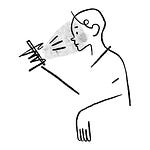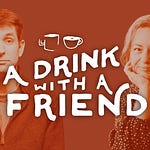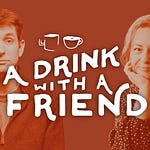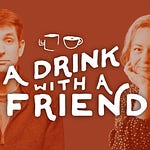There’s a purity to our childhood perspectives, and if we’re quiet enough, we can still hear them whisper to us. What do our first experiences with beauty, goodness, and truth tell us about what’s really there? Seth helps Tsh unpack a process he’s recently experienced as he listened to his nine-year-old self.
Seth: Newsletter | Twitter | Instagram | Website
Tsh: Newsletter | Twitter | Instagram | Website
Pick up the next round of drinks — help keep the show going!
Subscribe to the show’s Substack
Find all the episodes
Tsh’s Rule of Life workshop
Try Hallow free for 30 days!
The Lord of the Rings, by J.R.R. Tolkien
The Philosophy of Tolkien, by Peter Kreeft
The Summer of Helga, by Seth
The Suns We Orbit: Lessons Learned From Leaving the Church, by Seth
Scroll down for the transcript
Seth: Welcome to A Drink With a Friend, I’m Seth Haines.
Tsh: And I’m Tsh Oxenreider.
Seth: Tsh, what are you drinking today?
Tsh: I’m drinking some tea because I need some tea for both stress relief and caffeine. It is tea that my friend and long-time assistant, Caroline, sent me called Pimm’s floral gin bittersweet orange. It’s loose leaf tea. It’s in this thing and it’s good so far. It’s tea.
Seth: Is it orange-y?
Tsh: It’s orange-y but not in a bad way. The bittersweet is real, it’s not super sweet which I like. I don’t like super sweet. I was going to say, it’s got good stuff in the ingredients like elderberry and chamomile and orange peel and juniper berry and that’s supposed stuff that’s good for stress and that’s why I’m drinking it.
Seth: I don’t know if you’ve noticed this but orange flavors, there are two flavors that can be either really well done or really poorly done. Maybe three but I’m going to argue two. The first one is orange. Do you want to take a guess at the second?
Tsh: Lemon?
Seth: No, that’s a good guess, though. Cherry. When you’re dealing with orange or cherry or maybe grape, you can actually end up with something that’s really authentic tasting or something that tastes like bad antibiotics or bad…
Tsh: That’s a good way to put it.
Seth:…or bad cough medicine.
Tsh: Uh-huh. I like that. That’s really true. I love orange-flavored just about anything. You’re right, I hate the super fake tasting tastes like a lollypop orange. I don’t dig that. I love orange. I love orange and chocolate together, which I know a lot of people don’t like. Everyone in my family cringes and gives me all the orange things which I will happily take.
Seth: I also realized that I said antibiotics as if I’m English, which that’s weird. Maybe your Anglophile ways are rubbing off on me.
Tsh: [laugh] If you say ah-loo-minium in this episode, then we’ll know.
Seth: Or Hab-ah-cook if we’re talking about the Bible.
Tsh: I didn’t know that’s what they did. That’s funny. What are you drinking, Seth?
Seth: I don’t know if you can hear this? [pop can opening]
Tsh: Yep, I heard it.
Seth: Okay, that is a little crack of the top of some fancy fizzy water. Today, I’m going with the old standby, Perrier.
Tsh: You are being super-European.
Seth: I am. I feel like today is a sorta European day.
Tsh: Why Perrier?
Seth: It’s rainy here. It’s drizzly here. The world is a heavy place right now and I feel like we need a little fanciful beauty in our lives and whenever I say the word Perrier, I feel fanciful and dare I say, beautiful.
Tsh: There’s a reason for that but I’m going to say, hot take—give me Topo Chico anyway over Perrier. I find it to be a little low on the bubbly.
Seth: I think you’re just a little bit more blue-collar than I am today. Today, I’m sitting in my ivory tower drinking my Perrier.
Tsh: You do that. You look down on me all you want.
Seth: Listen, you are a woman of the people.
Tsh: I am, I’m a proletariat.
Seth: Yep.
Tsh: So, what’s on your mind today, Seth?
Seth: Tsh, we’ve talked a little bit about this and I’ve actually written a little bit about this lately. I’m really fascinated lately by the epiphanies, the early epiphanies of life that stick with you. The things that like, when you first experience them or see them, you can’t unsee them. You may have had a completely different trajectory up to that point. In fact, some of the narratives of your life might already be locked into the extent that even when you have these epiphanies you’re a little bit weary of them and you don’t fully own them. I had one of those epiphanies early on. I’ve been thinking about that a lot and I’m excited today to explore the epiphanies of youth. The things that happened when you’re young. Let me share a little bit about my own story and then we can go from there.
When I was a kid, I was raised in Arkansas, pretty much. We moved here when I was five. Most of my primary formative experiences were here. I was raised in a rural area early on. The kids there were really into what kids are always into: sports, fishing, hunting, all these rural ideas. To fit in at a very early age, I learned I better be able to hit a baseball. I better be able to dribble a basketball. I better be able to do all of these things well, fish well, in order to fit in. I didn’t really know any better. I was raised in a very evangelical home. Church didn’t have a whole lot of beauty to it, necessarily. There’s a type of beauty to it but it’s not like stained glass and art, that sort of thing. No shot against the Baptist here, Baptist friends. As of a result of where we were raised, there wasn’t a whole lot of beauty in my life. That said, my parents both loved music. They both loved art. Access was limited to it. I remember the summer before my fourth-grade year, we traveled to Washington, D.C. to visit the National Gallery. I know you’re a traveler, have you ever visited the National Gallery?
Tsh: No, I have not.
Seth: What?
Tsh: No, I know. It’s on my bucket list. Tell me more, why should I have been there?
Seth: I know you’ve been to museums in New York City and I know those are a bit more, you go to those, and maybe when you’re in D.C. you sometimes skip the National Gallery. But we went. I remember walking through, there were two exhibits at the time that were there, along with just the standing exhibits. The first that I remember, and I could be misremembering this, this may have been at a different museum but the first that I remember was either a collection of or one or two of the Fabergé eggs. Which if you’ve ever seen the Fabergé eggs, the minute you see one, you’re like, holy crap.
Tsh: Can I do a humble brag? I’ve seen Fabergé eggs in Moscow.
Seth: Ahhhh!
Tsh: They’re pretty remarkable. They are a bit otherworldly. It’s a whole thing. Honestly, those of you who subscribe to my newsletter, do a deep dive search for Fabergé eggs in the WRLD at home because I did a really fun podcast a few years ago on them. I think they’re really cool.
Seth: Can I do a humble brag and say I drank tea out of a Fabergé egg once?
Tsh: No. That’s kind of better.
Seth: That’s a lie.
Tsh: Oh, it’s a lie.
Seth: How in the world would I do that?
Tsh: That’s a humble lie.
Seth: It’s a humble lie. Anyway, we go to the National Gallery and we live out my humble lie and then we go to this other area where the paintings of Andrew Wyeth were hanging. It was a traveling exhibit, I don’t know where they got the paintings from but they had collected them. They were hanging in the gallery and we were walking through. It was really awkward because, again, it’s after my third-grade year, I’m a boy and Andrew Wyeth is very expressive with the female body which is very awkward when you’re a young child. But also, he has paintings that are just exquisitely done in their detail. I think we’ve talked about it on this podcast and I cannot remember the name of the painting, but the painting of the woman in the dress in the field. All the detail that goes into that painting. You look at it and you're like, holy moly, how did he do that? Pull out one strand of hair? Capture the way the wind works. I remember looking at the painting that I wasn’t too embarrassed to look at and thinking, wow, there is something objectively amazing about this. Now, I wouldn’t have said that because I was in third grade. I don’t know if I even knew what the word objective meant. There was something that more than intrigued me, it drew me. It helped me to see that there’s something beautiful in the world and that there’s some objective worth to objective beauty.
After that experience, we went home and then school started and I just happened to coincide that I was beginning a new school year in a new school. That new school was a Catholic school. I was a Baptist kid. I’d never been to a Catholic church, had zero context for what happened in a Catholic church. My parents had told me that it was kind of Episcopalian like it was Episcopalian heavy. I had some context for that because my grandparents were Episcopalian on one side. I knew there was going to be some standing and some sitting and some praying and that sort of thing. We walked into this beautiful church. It’s a church in Fort Smith, Arkansas called Immaculate Conception and it is not a cathedral but it should be. It has that feel particularly when you’re a little kid. I remember walking in, we walked in single file and I was astounded by the beauty of the place. There was this moment when I’m sitting there, not knowing what to do before the mass starts, we’re practicing the psalm, “I believe that I will see the goodness of the Lord in the land of the living.” That was the response, I still remember it all these years later. I still remember the response. I’m sitting there practicing this with my schoolmates as children do before an all-school mass and I was looking around at these strange statutes and this strange stained glass and all of these that I know now as stations of the cross. The light was coming in through the windows at awkward angles as in most of these old Catholic churches, when the light comes in a certain way you can see the shards cutting through the dust and the incense remnants. It was this moment of feeling absolutely transported somewhere else. When that was over, when the first mass was over, we went back and had lunch. I went outside and what did I do? I played basketball, maybe some kickball, I don’t know. Later that week, I fished. I did all the things I knew to fit in. It’s almost like I tried to not really wrestle with this thing. Of course, why would I? I was in the fourth grade. It would be years and years and years later until I would fully appreciate the confluence of these two events. This Wyeth exhibit and my first entrance into the Catholic church, the first time I walked into a Catholic church. I would come to the realization that my soul longs for beauty. Not abstract beauty. I am an abstract thinker. I’m an abstract person, as abstract as they come. But my soul and my personhood longs for something that is objectively transcendent and beautiful.
Tsh: Yeah.
Seth: I wouldn’t call myself an artist in any way for another, probably until I was in my early twenties or maybe late teens when I started playing music a little bit more. This was my first experience with beauty and it was epiphanal. It was a thing that stuck with me and now all these years later, I can’t shake it. It actually directs a lot of my life. My pursuit of beauty has directed a lot of my life.
Tsh: You were about nine years old or so, right?
Seth: I guess that would have been true, between third and fourth grade. Yes, is that nine?
Tsh: I guess. Around nine. The story you’re telling sounds to me like something I would have experienced in junior high/high school or even college. It’s interesting to me that that connection to beauty at that young an age has stuck with you. You know?
Seth: Yeah. Who knows why that is? I think we all have epiphanies at different ages and for different reasons. What I will tell you is that as I continued on in my own spiritual journey, no matter where I went, even when the sacred texts were really amazing, or whenever the prayers were really amazing, or whatever the case may be—there was always something just short. I could see the idea of objective truth but objective truth without objective beauty just left me really lacking. When I think about that, it doesn’t mean that objective beauty or that beauty has to be some ornate and extravagant display.
Tsh: Yeah, sure.
Seth: I think about Santa Fe, have you been to the cathedral of Saint Francis in Santa Fe?
Tsh: No, but I know exactly what you are talking about. I haven’t been there.
Seth: Yeah. It’s not ornate. It is in a sense but it’s not a big, huge display. It’s something very simple, the art is very simple. It’s very much what you’d expect in the southwest and yet the beauty is undeniable. When you worship in that place or when you stand in that place there is a connection between the beauty of objective truth and the beauty of objective beauty, of art. There’s something about that that really just pulls me and really helps me understand and focus on what is sacramental: where is God at work in the world around us.
Tsh: Since we love talking about sacramentality, that’s the whole point of our weekly conversations, the theme, and that beauty is the one that we both feel like in our lives have drawn us in..unpack a little bit why do you think your nine-year-old self who was also very preoccupied with fitting in and wanting to be a sports ball kid, why do you think God used that moment to give you a glimpse of what real objective beauty is or maybe I should ask, why do you think you responded to it?
Seth: I don’t know the answer to that. Again, I think probably we’re all created a little bit differently. We all have different strings that could be tugged at different times to pull us in a certain direction. I don’t know if that’s too metaphorical. For me, I was always a deep feeler. I wasn’t just a deep thinker, I was also a deep feeler, from the very early stage. I remember feeling music, feeling the tug. When I was six, here’s another story. When I was six years old, I was given this radio by my aunt and uncle and there was a plug-in on the other side of the room where I could plug in this radio. I would sneak out of my bed at night and I would crawl across the floor with my blanket and my pillow and I would lie on the floor and turn it down as low as it would go and hold it to my ear so I could hear it. I would wait for the Foreigner song, “I Want to Know What Love Is”, at which point, I could fall asleep. I don’t understand it, it’s the weirdest thing. It’s a weird confession. From the earliest age, I was a really deep feeler. I think some people come to their realization of feeling an art later in life and that’s okay. There are different seasons and different times for different people. But I think for me, I reckon anyway, that God knew that to keep my attention, he was going to have to show me something beautiful and he was going to have to do it pretty damn quickly. For me, the idea of objective through an exegesis of a preacher on the podium was never enough to hold me.
Tsh: Right. To me, this shows because you weren’t seeking it out and because you were a nine-year-old boy for all intents and purposes, how it is innate in us just in the human experience. Being a human being on earth means we’re drawn to beauty by nature of what beauty does and who we are as humans because you didn’t seek it out and you would have never created something like that on your own, you had to be shown it from outside yourself. We’ve all had those experiences. I’m sure listeners listening in are hearing this and thinking, I have been there before. I have my story that’s somewhat akin to that. We nod along in these kinds of things.
Seth: I think it’s important to go back to those moments as a child and to revisit and examine those moments as a child, the important poignant moments. I was actually talking to a friend of the show, who has not been on the show, I don’t think? A friend of the show, Annie Downs, a while back.
Tsh: She’s been on the show but it’s been a long time.
Seth: Okay. Annie said to me something that was amazing. She said, these days I’m asking myself how do I honor, respect, and protect little girl Annie? I think what’s she’s saying there is how do I look back on my life and say all of this baggage I’ve heaped on in adulthood that’s not actually a part of my authentic self? How do I undo that baggage and go back to that place that was my authentic self? Before I learned to put up facades before I learned to put on shows? I think for me, that’s what those experiences, those epiphanies do. They remind me that I have a job to do. My daily grinding job is not to create beauty. The daily grind of taking the kids to the ball game has nothing to do with beauty. Cooking dinner doesn’t necessarily have anything to do with beauty. But when you strip all those things away and ask what it takes to really fuel me and to keep me connected to my authentic self, the truth is I need beauty in my life.
Tsh: I like that Annie’s bit wisdom there can actually be advice to all of us. I’ve done an episode on the show when it was The Good List called Your 5 & 85 Year Old Self. Tate and I were literally talking about this over the summer. The idea being, from an artist, this isn’t my original idea, the people we should care about in our lives right now impressing is our 5-year-old selves and our 85-year-old selves. The reason is because it helps us think about the past and the future. For the sake of this conversation, our past selves, think about what would have made your five-year-old self just proud of you? It came true yesterday for Tate because she got her driver’s license. She passed the test. She said, my six-year-old self is really proud of me right now. I said, why six in particular? It’s me ten years ago and that’s when I first remember really wanting my driver’s license.
Seth: That’s awesome!
Tsh: I thought that was really cool. But we all have that, right? We can all think of who we were then and the stories we told ourselves, the stories that resonated with us like the one that you talked about. I think there’s really some truth to our childhood selves speaking into our present.
[AD BREAK}
Seth: Let’s practice a little bit. What is a childhood moment, memory, epiphany of yours that stands out?
Tsh: I’ve been thinking about this since you started talking because I can come up with really poignant, enriching deeper stories later in life but I want to take a queue from you and stick to my younger self. For me, there are two that come to mind but they’re not actually one-off memories, they’re repetitive memories. Things that I would do. Maybe I need to go somewhere different but you tell me. The first one is from age three to sixteen, I was in ballet which is a really long time when you’re a kid. It was my entire life and once I hit my teen years I was doing it six days a week. I thought it might be a career path for me for a while. When I was younger, I remember there was a point when I was about eight when I crossed some rubicon from being terrified to being on stage to loving it. When I think about that age a recurring memory I have, because I did two shows a year, is the feeling I got right before I got on stage. If you were to ask me, think of yourself at age eight, the place I’m instantly portaled back to is off stage right before I’m about to go on and that feeling I have. It’s not about performing in a look at me way, it’s about as soon as I would go on stage, I lost myself in it. The music and the movement. It was like that was the closest thing to home I had felt outside of just being in my own bed in my own cozy bedroom. I was a shy kid. I was a nerdy kid. I was not showy at all. The worst part of all of this were the costumes where for some girls it was their favorite part, for me it was oh my gosh, can’t I just wear what I wear to ballet class? I hate this part. Just to show you what kind of kid I was. That to me, is interesting that what really connected to me even at that young age was the music and the movement. Then alongside that, I frequently, because this was the eighties, would in my childhood just go off in our neighborhood to this one spot in a creek. In our suburban neighborhood but there was a creek that ran through it, it was like a dry bed with all this cool limestone rock and there was a tree I loved because it had all these exposed roots and it was really cool. I would go to this one little spot and I had a seat made out of rock and wood given by nature, I didn’t create it, in between these two roots and I would just go and read. I wanted to be there pretty much more than anywhere else when I was a kid when it came to my happy place. Going there a lot. I went there probably like six or seventh grade. I don’t think my parents ever knew about it. It was like I was hiding it was the eighties, just get home by dinner.
Seth: Be home by dinner, don’t talk to Pennywise.
Tsh: Exactly. Those are the two memories that come to mind from my childhood.
Seth: What was it about the secret place for you?
Tsh: Hmm, I think some of it was, in the name, I liked that nobody else knew about it so it felt really, not juicy, but Terabithia-like. This is my particular kingdom. There were people that would walk by, it wasn’t hidden. It was just along the hike and bike trail but it felt like it was like I planted a little metaphorical flag there that was mine. It’s not like I grew up in a big family, I only had one sibling and I had my own room but there was something else. It was almost like I could just decide what I wanted. It felt autonomous. I think also it was very rustic because it was nature, literal outdoors. There was nothing polished or prescripted about it, it was what it was. It was like there was that seat that just was an invitation. I didn’t create a seat at all, it was given to me by the rock.
Seth: It was always the same, did you always do the same thing? Was it always reading?
Tsh: It was usually reading but I also did some things like I tried to climb the tree a couple of times. It was a really big live oak because, Texas. I did that some. I tidied it. I would arrange the rocks. There was this book from my childhood that I loved because they created this make-believe world where they aligned the rocks and those became the roads of a town, some friends in the neighborhood. So I almost made it a place of my own, I arranged it, but I still left it wild. I didn’t add pompoms or glitter. Those are probably the two things that I did.
Seth: When you look back on that moment and again, we’re mucking about in the space of epiphany, mine were two really connected epiphanies but it’s easy to say that looking back because I’ve now connected the epiphanies. Those were the things that have happened and now I’ve made the connection and I can’t un-connect it. When you look back at that, how do you see that influencing your life now?
Tsh: That’s a good question. I’ve long known that I highly value autonomy, getting to make a space my own. Gosh, that’s a great question. The natural beauty and the ruggedness of a space even in the suburbs I think really deeply spoke to me. I wonder if I can pull that thread to my almost forty-four-year-old self now and see that that is a common theme whenever I’m somewhere even in a city, I liked to find the natural, the unformed, the made by God beauty. Even if I can appreciate the architecture or manmade art. But I’m trying to think of why. What is it about nature that speaks to me but I definitely see that theme of beauty like you talked about that I hadn’t thought about before.
Seth: Is there a saint that steps out history to you?
Tsh: Two. Saint Francis. Frank is my dude.
Seth: Franky.
Tsh: In a lot of ways for a lot of those reasons related to nature. Then, someone that I’m just now learning from the past eighteen months and that’s Kateri Tekakwitha, I don’t know if I’m saying that right? Our first Native American saint. She’s the patron saint of ecology. I really like her and I like her story, a lot.
Seth: Do you know where there’s a statue of her?
Tsh: Where? Tell me.
Seth: The Cathedral of Saint Francis in Sante Fe.
Tsh: That’s weird.
Seth: I think that’s true. We’ll have to double-check that. We’ll have to fact-check. We’ll get our fact-checking team on that.
Tsh: Yeah. I didn’t know that.
Seth: I think it’s interesting when you’re talking about these things. The innate connection of our childhood epiphanies to our modern spirituality, to what connects with us now in the here and now. Those things that tug on you and pull you, and pull you, and pull you. Those are the things that ultimately become defining in your adulthood and in your adult spirituality. For instance, I love this idea of art in church. If I were to have to go to a Quaker assembly and sit, I love the silence because I do love silence. It’s also a deep part of who I am but looking around a white room with ruffian pews might not do it for me. But for you, you might walk into a Quaker space and feel really at home, maybe not worship there every week. Again, it’s the quiet place, it’s the secret place, it’s silence, it’s ruffian. I think it’s important that we explore these things. There are spaces that I walk into, in fact, this happened in Marfa, Texas. I visited a church in Marfa and it was the most Marfa thing about Marfa. The Catholic church in Marfa is literally the most Marfa thing about Marfa. It feels like an installation.
Tsh: Really. Oh, man.
Seth: In a sense, it’s like so totally Marfa that it makes a lot of sense. They have three LED lights that go around the cross, the crucifix.
Tsh: Oh, gosh. Okay.
Seth: The floor under the altar is red painted. It’s really interesting. The most Marfa thing about Marfa was the Catholic church and it fits the personality but for me, it would be very difficult to worship there because it’s a certain type of beauty that’s not the same thing that I look for. I think all of these things in our adult years really come together to say who are you, where do you worship best, where do you connect with the saints, where do you connect with the world of God in your life? Go be true to those places and go find those places.
Tsh: I really like that. Hearing you talk, we’ve talked about this on the show before when I go to places like cathedrals and museums, I often pick up a rock on the way in or somewhere in that area and keep it in my pocket. Because when I’m looking at this hauntingly beautiful art, which I love, I love manmade art, I like to have a tethering to the natural. I don’t know what it is. To me, it feels like I’m tied back to the dock of God in that way. That’s really interesting to put it that way. I hadn’t thought of it before.
Seth: The fact-checkers have also come back and have informed me that the stature is in fact outside of the Cathedral of Saint Francis. I think you should put that on your list of places to go, stat.
Tsh: That is bizarre and cool. Okay. Kyle, take note, we might have to go there next time. We almost drove through Santa Fe on our way up to Oregon this summer.
Seth: Argh.
Tsh: Maybe we’ll have to next summer? Yeah.
Seth: How far away is it from you?
Tsh: Ten hours.
Seth: You could do that in two days. Just take off next week and go do it.
Tsh: In all my spare time right now. Yeah.
Seth: For me, as I’m thinking this through. I think the ultimate question that I hope we all ask and I hope I ask and that we can keep pressing into here is what are the things that stand out to us, the epiphanies that stand out to us early in life and how can we honor those epiphanies with our journeys and live into it? I think it’s really important. I think it’s important that we don’t get co-opted by these powers of politics or pop culture, whatever the thing is. Now I sound like an old man right now but that we honor those epiphanies over those powers.
Tsh: Right. I think in our busy days, at the time that we’re recording this at least in the Northern Hemisphere we’re heading into fall and therefore a school year for many of us parents. It’s easy to just do the thing in front of us because we’re just in survival mode. I like the invitation this gives us to listen to those quiet stories. Listen to the stories our five-year-old self is telling us about what matters to him and her in life. Maybe honor that by just listening and paying attention. I think it’s the work of paying attention, which is what we talk about here on this show all the time. It’s not about having these amazing cathedral moments all the time. It’s about while you’re stirring the soup. Hear what comes to you and don’t ignore that.
Seth: That’s right.
Tsh: That’s good. Seth, what in your life is bringing you more beauty in your everyday, speaking of which?
Seth: I think you know this. Maybe we’ve even talked about it before. We are on what feels like the never-ending journey from the Shire to Mordor in my house. We’ve been reading The Lord of the Rings trilogy now for I think two years, just so slowly. Part of it is basketball season will come up and we’re disrupted for three months or whatever, school, COVID, whatever you want to call it. We just keep getting disrupted. We’re almost through the second book. We’re legitimately…
Tsh: That’s impressive.
Seth: Yeah, it’s awesome. I think it’s 700 pages or something. Last night we sat down to read again. We read three times this week which is amazing for our family. Man, every time I read, not every time, but when I read Tolkien I forget how good he is. He’s so good. There are these moments when you’re reading particularly Lord of the Rings where you almost feel like you’re getting in a rut, two, three, four, five pages sometimes. Sometimes a rut feels like it goes on and on.
Tsh: It’s like how many ways can you talk about trees?
Seth: Yeah, or how long do you need to describe a rock?
Tsh: Exactly.
Seth: Do you need five sentences, really, to do this? Which reminds me of The Last of the Mohicans, a completely different other story but I feel that way about The Last of the Mohicans, too. Anyway, that’s neither here nor there.
Tsh: The book or the movie?
Seth: The book.
Tsh: The book is the worst.
Seth: It’s the worst. I say it’s the worst, that’s not 100% true because believe it or not, I hate Great Expectations.
Tsh: Oh, it’s not great. It’s mediocre expectations, for sure.
Seth: Mediocre expectations, that’s right. Last night, we were reading and he has these moments where he’ll string three pages of paragraphs together that make you want to weep because he’s such a good writer. We’re in that section last night where they’re on their way to Mordor and he’s describing the land. For whatever reason, it reminded me of the opening John Steinbeck’s, East of Eden. The way they both describe the flora and fauna of a place even though Steinbeck’s is really beautiful and this particular passage of Tolkien is very dark. Boy, they can both write. I think what I’m coming to find out is I really love it when a writer does super interesting things with landscape.
Tsh: I get that.
Seth: Now, reading landscape is bringing a lot of truth, beauty, and goodness to my life.
Tsh: I really get that, to bring it full circle to the conversation we had earlier. I understand how writing where the landscape feels like another character. There’s a sacred work to that that is hard to do but makes a story what it is. You can’t imagine The Lord of the Rings in any other place in any other type of way. You can’t even imagine the tress being different or the rocks or the grass being different because of the way he writes it so that’s a great way to put it.
Seth: Yeah, which is why when everyone sees the movie, this is exactly how I imagined it. Of course, because he was so detailed. It also reminds me of your comment last week about Evelyn Waugh’s writing and particularly our conversation about the storm. Just the ability to see the storm as a character. See things with unnamed character as character.
Tsh: I’m going to add in the show notes as well, but I’m going to send it to you. There was a recent episode of a podcast, Pints with Aquinas, where he was talking with Peter Kreeft and they were talking about Lord of the Rings. Matt Fraad asked him why do you think Lord of the Rings is so good? I love Peter Kreeft. The way he phrased it was spot on perfect because he talked about even though Middle Earth is fantasy it’s real-er than our Earth. He gets into how it’s real-er because of Tolkien’s writing. It’s like the swords are sharper. The grass is greener. The heroes are more heroic. I thought that is it. That’s what you’re speaking into and I love that.
Seth: I think part of the reason we all feel this is because he’s able to create such flawed characters and landscapes that can co-exist with such beautiful characters in the characters and in the landscapes. That’s what makes it real because we all know that ideals are really exactly that, they’re idyllic. They’re not real.
Tsh: Right.
Seth: Tsh, tell me, what’s one thing this week that you’re reading, watching, listening to, maybe cooking, we’ve done that one, that is bringing you more truth, beauty, or goodness?
Tsh: We all know what’s going on with Afghanistan in the news. We can’t escape the soundbites and the headlines and they invite us to doom scroll if we’re not careful. This happens a lot with certain newsworthy events. This happened with Syria, this has happened all sorts of times. Name an event and you can just get lost in the sadness of it all. There’s legitimacy to that. But one of the things that I do in my newsletter that I encourage other people to do because I’m encouraging myself to do, is to peel back the layer of what is the headline to see what’s really there and who is it we’re really talking about. Who are the people, what are the places actually like? One of the things I did after reading headlines and getting caught up on the news because I don’t want to bury my head in the sand is I stop doing that when I feel like I’ve got the gist. I know enough. Teach me about the places. I went to YouTube actually and started searching Afghanistan travel instead of Afghanistan news. I came upon this one guy I had never heard of but apparently, I’m the only one because he’s got 2.3 million subscribers. His name is Drew Binsky. Have you heard of him?
Seth: No, I haven’t.
Tsh: Then it’s you and me. He is a travel videographer. A travel vlogger, I guess. He is young, maybe mid-twenties and he is on a quest right now to go to all the countries in the world which you can do when you don’t have kids. He recently went to Afghanistan for the second. This was back in November 2020. We’re talking less than a year out from the recording of this. I wanted to see, just give me boots on the ground, every day, the real people story. I just got lost on a rabbit hole on some of his videos and so I’m going to put in the show notes some of my favorite videos of his because it just told me about a day in the life stuff. About kids playing cricket and how it’s the national pastime of Afghanistan. I did not know that. About what his favorite street food is, it looks amazing and delicious, from Kabul. About some of the really cool architecture. About the last living Jew that lives in Afghanistan.
Seth: Wow.
Tsh: It’s just so cool. I say all this to come full circle and say whenever we’re in the midst of news, let’s remember to hear about the people and not just the enraging headlines that are supposed to cause us to feel a certain way. It’s a sacramental work of beauty and goodness for us to do that because we have to seek it out. It’s not going to be put in our laps. That’s not what’s going to be in our Twitter feeds. To go seek it out and then to learn about people. The kids and I were just talking today, sometime let’s go find an Afghani restaurant. I don’t know if there’s one in this area but if not Afghani, some other culture-adjacent, Persian, or something. Let’s go eat and support them and let’s remember that we’re just a tiny blip in the world. I think it’s good for us all to do that sometime. That’s what’s adding more beauty to my life.
Seth: That’s awesome. What’s his favorite street food, by the way?
Tsh: I can’t remember the name of it, it’s got an interesting name. It’s a street food that I think most cultures have a version of. Kyle and I say that every culture has some kind of donut-shaped bread. A bagel or something. It’s not that but it’s another street food everybody has and it’s some sort of folded pastry with stuff in it and it’s that. It’s the thin pastry dough full of vegetables and meat.
Seth: Like phyllo with stuff in it?
Tsh: Yeah. It’s a version of that.
Seth: It is an Afghani calzone.
Tsh: Or a crepe or insert folded food.
Seth: Or, if you’re from Louisiana, we just used to call them meat pies.
Tsh: There you go, it’s an Afghani meat pie that I can’t remember the name.
Seth: An Afghani meat pie. That’s awesome. I want to follow this, make sure you put it in the show notes so that we can all now follow him. Everybody will probably say, oh, Tsh and Seth, you guys are so stupid. How did you not know about this guy?
Tsh: Exactly. I feel like that anytime I run across somebody that apparently everyone knows about. I’m just an old man on the internet at this point.
Seth: Again, we just go back to the oldness. [old man voice] Tsh, have you ever heard of this guy?
Tsh: The youth have stopped listening by now.
Seth: That’s probably true.
Tsh: Alright, it’s time to wrap this up. You can find this episode, as well as all episodes, at adrinkwithafriend.com. If you like this show and what we’re doing here, you can help keep it going by picking up the next round of drinks! This show is free for you to listen to but it’s not free for us to make, so at the cost of a cup of coffee or a pint, you can play a big part. Find the link to do this in the show notes of this episode, or at adrinkwithafriend.com, and thanks so much in advance for your partnership.
Also, a reminder to check out Hallow free for 30 days at hallow.com/drinks. I am currently following along with them praying the Emergency Nine Day Novena for Afghanistan through Hallow. It’s really great. I think you’ll like it. Again, that’s hallow.com/drinks, or find the link in the show notes. You can find me and how to connect with me, especially via my newsletter, at tshoxenreider.com. Seth, where can people find you?
Seth: sethhaines.com and that’s Haines with an “I” not like the underwear is spelled.
Tsh: Music for the show is by Kevin MacLeod, editing is by Kyle Oxenreider, and Caroline TeSelle is our transcriber and assistant extraordinaire. I’m Tsh Oxenreider with Seth Haines, and we’ll be back here with you soon. Thanks for listening.













Listening to Our Childhoods